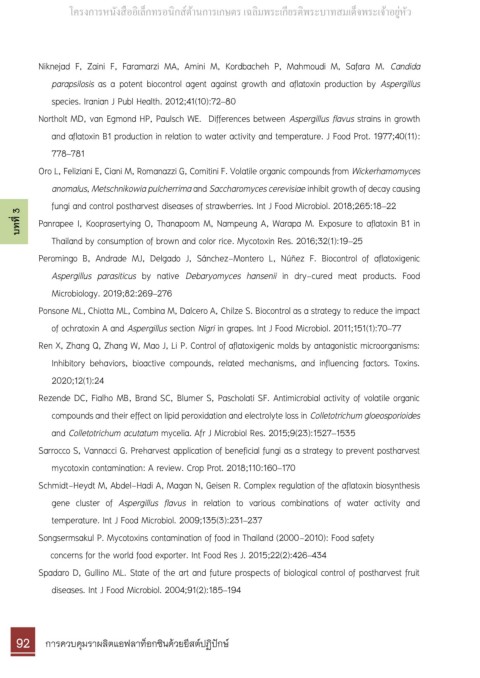Page 101 -
P. 101
ิ
์
ิ
โครงการหนังสออเล็กทรอนกสด้านการเกษตร เฉลมพระเกียรตพระบาทสมเด็จพระเจ้าอยู่หัว
ื
ิ
ิ
Niknejad F, Zaini F, Faramarzi MA, Amini M, Kordbacheh P, Mahmoudi M, Safara M. Candida
parapsilosis as a potent biocontrol agent against growth and aflatoxin production by Aspergillus
species. Iranian J Publ Health. 2012;41(10):72–80
Northolt MD, van Egmond HP, Paulsch WE. Differences between Aspergillus flavus strains in growth
and aflatoxin B1 production in relation to water activity and temperature. J Food Prot. 1977;40(11):
778–781
Oro L, Feliziani E, Ciani M, Romanazzi G, Comitini F. Volatile organic compounds from Wickerhamomyces
anomalus, Metschnikowia pulcherrima and Saccharomyces cerevisiae inhibit growth of decay causing
fungi and control postharvest diseases of strawberries. Int J Food Microbiol. 2018;265:18–22
บทที่ 3 Panrapee I, Kooprasertying O, Thanapoom M, Nampeung A, Warapa M. Exposure to aflatoxin B1 in
Thailand by consumption of brown and color rice. Mycotoxin Res. 2016;32(1):19–25
Peromingo B, Andrade MJ, Delgado J, Sánchez-Montero L, Núñez F. Biocontrol of aflatoxigenic
Aspergillus parasiticus by native Debaryomyces hansenii in dry-cured meat products. Food
Microbiology. 2019;82:269–276
Ponsone ML, Chiotta ML, Combina M, Dalcero A, Chilze S. Biocontrol as a strategy to reduce the impact
of ochratoxin A and Aspergillus section Nigri in grapes. Int J Food Microbiol. 2011;151(1):70–77
Ren X, Zhang Q, Zhang W, Mao J, Li P. Control of aflatoxigenic molds by antagonistic microorganisms:
Inhibitory behaviors, bioactive compounds, related mechanisms, and influencing factors. Toxins.
2020;12(1):24
Rezende DC, Fialho MB, Brand SC, Blumer S, Pascholati SF. Antimicrobial activity of volatile organic
compounds and their effect on lipid peroxidation and electrolyte loss in Colletotrichum gloeosporioides
and Colletotrichum acutatum mycelia. Afr J Microbiol Res. 2015;9(23):1527–1535
Sarrocco S, Vannacci G. Preharvest application of beneficial fungi as a strategy to prevent postharvest
mycotoxin contamination: A review. Crop Prot. 2018;110:160–170
Schmidt-Heydt M, Abdel-Hadi A, Magan N, Geisen R. Complex regulation of the aflatoxin biosynthesis
gene cluster of Aspergillus flavus in relation to various combinations of water activity and
temperature. Int J Food Microbiol. 2009;135(3):231–237
Songsermsakul P. Mycotoxins contamination of food in Thailand (2000-2010): Food safety
concerns for the world food exporter. Int Food Res J. 2015;22(2):426–434
Spadaro D, Gullino ML. State of the art and future prospects of biological control of postharvest fruit
diseases. Int J Food Microbiol. 2004;91(2):185–194
92 การควบคุมราผลิตแอฟลาท็อกซินดวยยีสตปฏิปกษ

